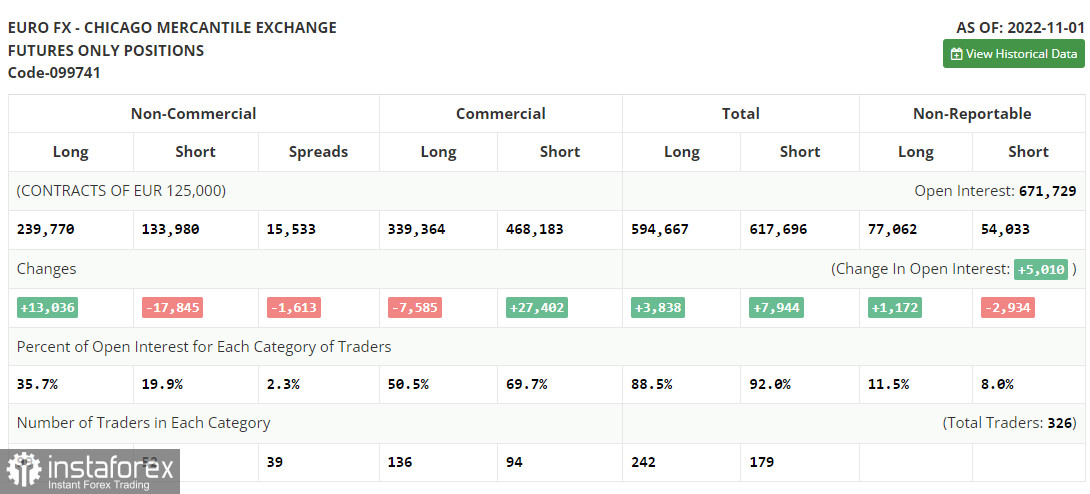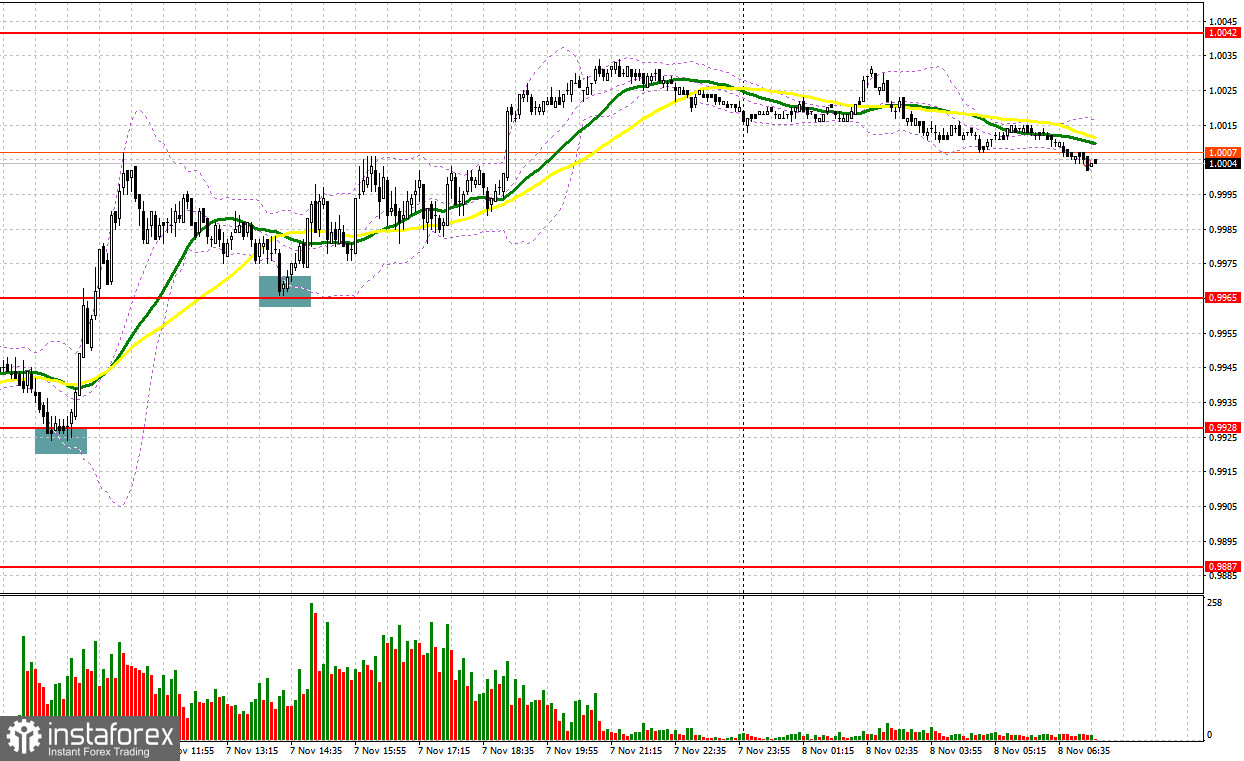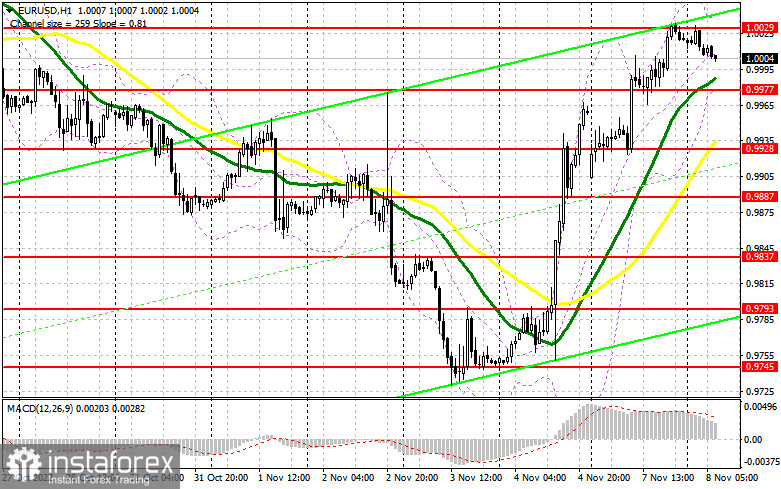Yesterday, traders received several perfect signals to enter the market. Let us take a look at the 5-minute chart to figure out what happened. Earlier, I asked you to pay attention to the level of 0.9928 to decide when to enter the market. A decline and false breakout of this level provided buyers with a perfect entry point. As a result, the pair gained more than 70 pips. In the second part of the day, a breakout and a downward test of 0.9965 gave another buy signal, which allowed the pair to climb by 40 pips.

Conditions for opening long positions on EUR/USD
Before we focus on the euro's further movement, let us take a look at the futures market and the COT report. According to the COT report from November 1, the number of both short and long positions dropped. The US dollar continues losing value against risk assets despite the fact that the US Fed remains stuck to its approach. Most traders suppose that the regulator will end its aggressive tightening as early as next spring. After that, it is likely to start cutting the key interest rate quite smoothly. This may considerably boost demand for the euro. This week, such a rise could be triggered by the US inflation report, which has been shaping the Fed's approach. If inflation declines, the US dollar will lose value and the euro will confidently consolidate above the parity level. However, the bullish potential of the euro is also limited. The fact is that the ECB may revise its aggressive monetary policy after a sharp rise in the key interest rate. However, this will happen if the eurozone economy continues contracting. The COT report unveiled that the number of long non-commercial positions increased by 13,036 to 239,770, while the number of short positions dropped by 17,845 to 133,980. At the end of the week, the total non-commercial net position remained positive at 105,790 against 74,909. This indicates that investors continue benefiting from the situation and buying the cheap euro below parity, as well as accumulating long positions, expecting the end of the crisis. The weekly closing price rose to 0.9918 from 1.0000.

I suppose that the upward potential of the euro will be capped. Only the US inflation data will determine a further movement of the asset. Traders will hardly show a strong bullish reaction to speeches that will be provided by Buba Wuermeling and ECB's Enria. What is more, traders may ignore the eurozone retail sales data for September. To maintain the upward trend, bulls should protect the nearest support level of 0.9977. If the pair drops, only a false breakout will allow traders to go long, expecting an upward correction. In this case, the pair will have a chance to reach a new resistance level of 1.0026 formed yesterday. A breakout and an upward test of this area will allow the pair to hit a new high of 1.0090. In this case, the price may climb even higher to 1.0136. The farthest target is located at 1.0182. If the price hits this level, the market situation will change dramatically. Traders should lock in profits at this level. If the euro/dollar pair declines and buyers fail to protect 0.9977, the situation will stabilize somehow. Only a false breakout of the support level of 0.9928 will give a reason to buy the euro. Traders may also go long just after a bounce off the support level of 0.9887 or lower – from the low of 0.9837, expecting an upward correction of 30-35 pips.
Conditions for opening short positions on EUR/USD:
Sellers have just little intention to regain control over the market under the current market and economic conditions. However, the situation may change at any moment. Recently, traders have been showing a stronger reaction to the data from the US. There are several reasons for that. Traders try to find out whether the US economy is tipping into a recession or the Fed is able to keep a balance between high interest rates and slower GDP growth. Buyers of the euro will have an advantage until the US publishes important reports. Today, traders may go short after a false breakout of the nearest resistance level of 1.0029. The pair may climb to this level amid strong data from the eurozone. The fact is that the retail sales growth will keep hope for a rapid GDP rise at the end of the year. A failure to fix at this level will lead to a drop to 0.9977. A breakout and settlement below this level as well as an upward test will give an additional signal to sell the euro with the target at 0.9928, where it is recommended to lock in profits. The pair will be able to slide deeper only amid strong data from the US that will hardly be published today. If the euro/dollar pair increases during the European session and bears fail to protect 1.0029, the pair will jump. In the event of this, traders should avoid selling until the price hits 1.0090. A false breakout of this level will allow sellers to enter the market. Traders may also go short just after a rebound from the high of 1.0136 or even higher – from 1.0182, expecting a decline of 30-35 pips.

Signals of indicators:
Moving Averages
Trading is performed above 30- and 50-day moving averages, which points to a further rise in the euro.
Note: The period and prices of moving averages are considered by the author on the one-hour chart which differs from the general definition of the classic daily moving averages on the daily chart.
Bollinger Bands
In case of a decline, the lower limit of the indicator located at 0.9977 will act as support. A breakout of the upper limit of the indicator located at 1.0030 will lead to the euro's appreciation.
Description of indicators
- Moving average (moving average, determines the current trend by smoothing volatility and noise). The period is 50. It is marked in yellow on the chart.
- Moving average (moving average, determines the current trend by smoothing volatility and noise). The period is 30. It is marked in green on the graph.
- MACD indicator (Moving Average Convergence/Divergence - convergence/divergence of moving averages). A fast EMA period is 12. A slow EMA period is 26. The SMA period is 9.
- Bollinger Bands. The period is 20.
- Non-profit speculative traders are individual traders, hedge funds, and large institutions that use the futures market for speculative purposes and meet certain requirements.
- Long non-commercial positions are the total number of long positions opened by non-commercial traders.
- Short non-commercial positions are the total number of short positions opened by non-commercial traders.
- The total non-commercial net position is a difference in the number of short and long positions opened by non-commercial traders.
 English
English 
 Русский
Русский Bahasa Indonesia
Bahasa Indonesia Bahasa Malay
Bahasa Malay ไทย
ไทย Español
Español Deutsch
Deutsch Български
Български Français
Français Tiếng Việt
Tiếng Việt 中文
中文 বাংলা
বাংলা हिन्दी
हिन्दी Čeština
Čeština Українська
Українська Română
Română

